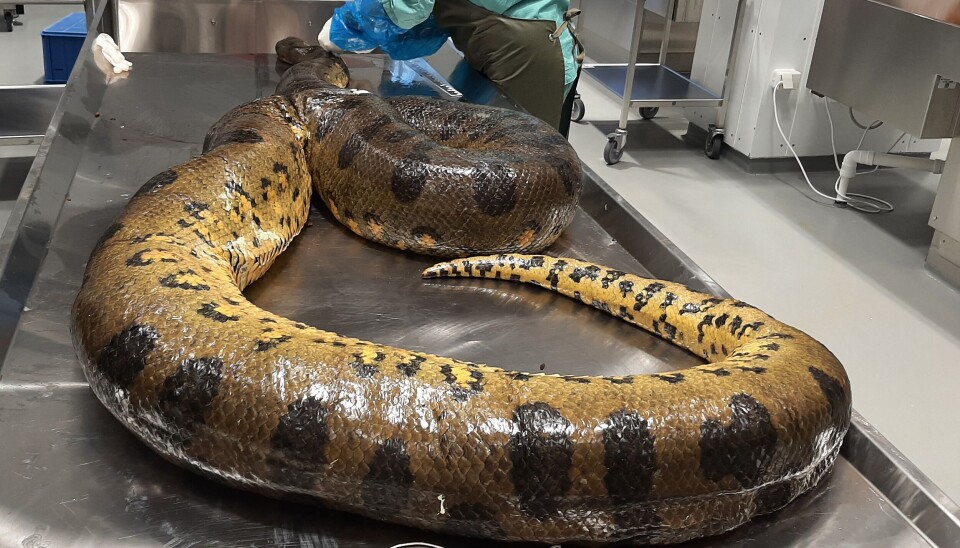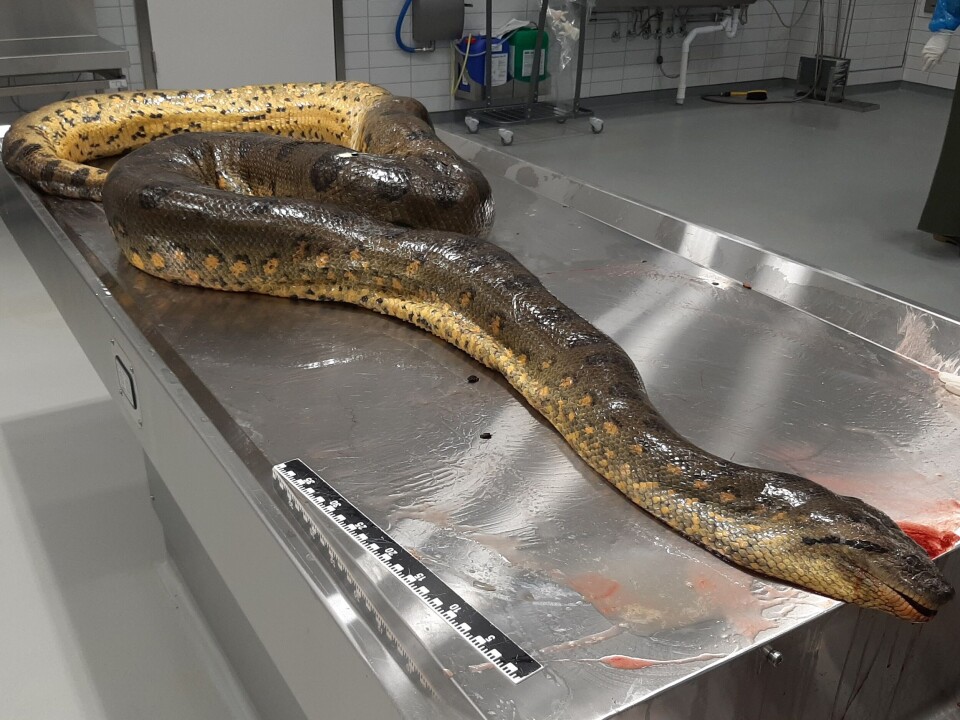THIS CONTENT IS BROUGHT TO YOU BY The Norwegian Veterinary Institute - READ MORE

The sudden death of this anaconda in Norway led to an unusual necropsy
The beast weighed 75 kilograms and was 6 metres long.
It was a slightly 'longer' working day than normal for the Norwegian Veterinary Institute when a reptile over 6 metres long and weighing 75 kilograms had to be necropsied.
An anaconda died suddenly, and to find the cause of death, the carcass was sent to the institute in Ås for necropsy and examination.
From the Amazon to Hallingdal
The anaconda is a constrictor snake and is the world's heaviest snake. It naturally lives in swamps around the Amazon.
The snake can weigh over 100 kilograms and grow between 6 and 9 metres long.
It is also found in zoos in many countries, including Norway.
The anaconda that ended its days on the autopsy table in Ås lived in the Bear Park in Hallindal, when it suddenly died.
Lesions were found in the intestine, which is typical for a salmonella infection.
A varied menu
According to the Great Norwegian Encyclopedia, the anaconda is a nocturnal constrictor snake. It typically hunts in water by swimming submerged with only its eyes and nostrils above the water's surface. From there, it attacks animals that come to the water's edge to drink.
Mammals, birds, reptiles, and fish are included on its menu. Large snakes sometimes manage to capture mammals as large as deer, tapirs, and hippos.
Cannibalism occurs. It is usually a female that eats a male.
There are assertions that it can potentially kill and consume humans, but there is a lack of strong evidence to support this claim.
Not an everyday occurance
It is not often that the Norwegian Veterinary Institute receive an anaconda or other unusual reptiles or animals on its autopsy table in its facilities.
However, it can happen if the animal owner wishes to find out why a healthy animal has suddenly died.

"It can be important to find the reason why an animal in a herd has died, especially in cases where an infectious disease is suspected," Kristian Hoel says. He is section head of pathology at the Norwegian Veterinary Institute.
He indicates that conducting a necropsy can be an important tool for identifying the root cause and associated factors of various medical conditions.
Pathology and disease diagnosis
When carrying out necropsies of animals, the Norwegian Veterinary Institute contributes with its experts in pathology and disease diagnosis.
Necropsies also provide opportunities to research ovarious diseases. They contribute to even more knowledge about the animals.

This content is paid for and presented by the Norwegian Veterinary Institute
This content is created by the Norwegian Veterinary Institute's communication staff, who use this platform to communicate science and share results from research with the public. The Norwegian Veterinary Institute is one of more than 80 owners of ScienceNorway.no. Read more here.
More content from the Norwegian Veterinary Institute:
-
Prions found throughout the body in moose and red deer with sporadic chronic wasting disease
-
Can Norwegian reindeer provide new insights into chronic wasting disease?
-
A new method can provide improved PD monitoring of farmed fish
-
Tick-borne encephalitis-virus found in unpasteurized cow milk in Norway
-
How many CWD-infected animals are out there?
-
Wild and farmed fish infect each other





































